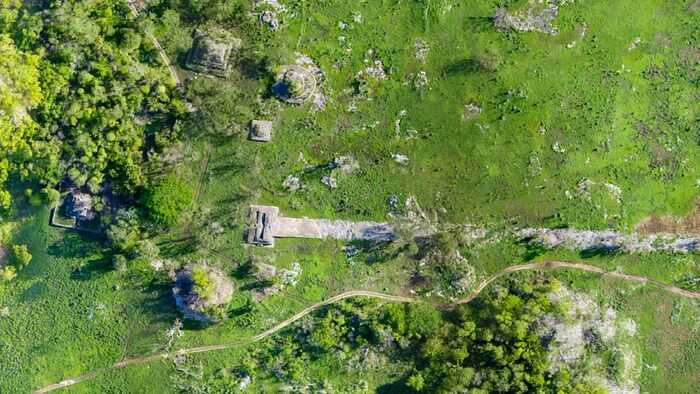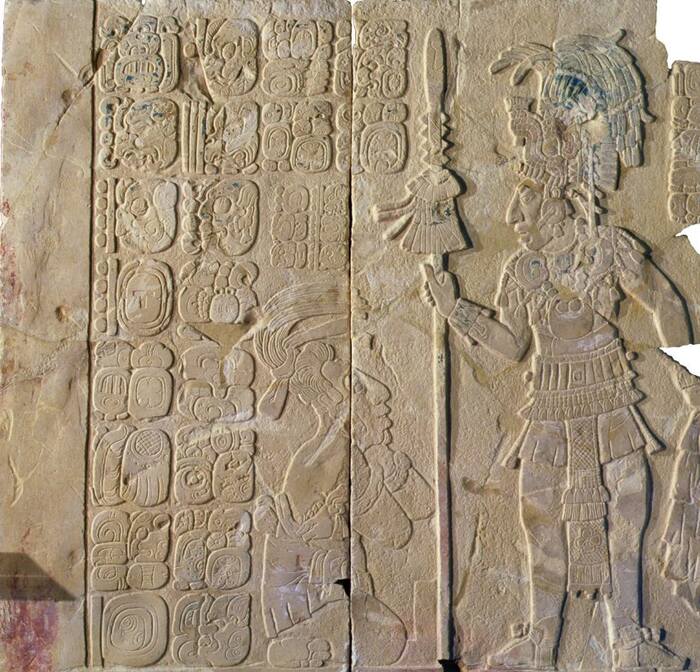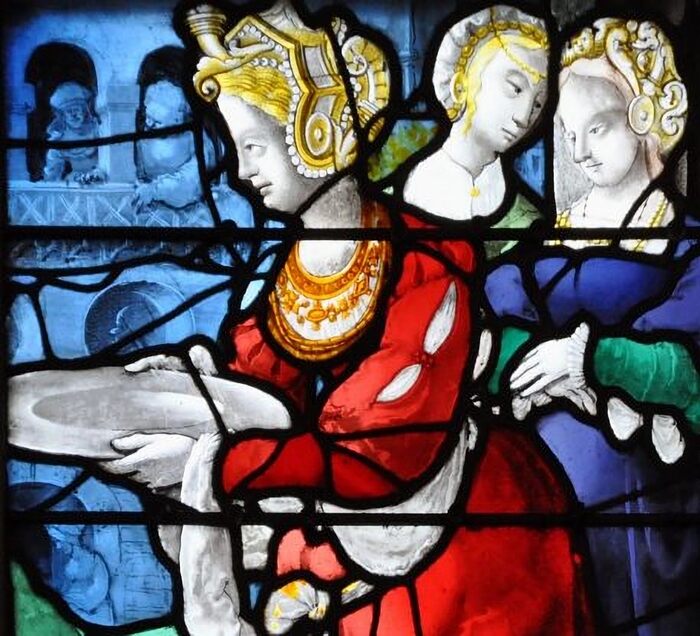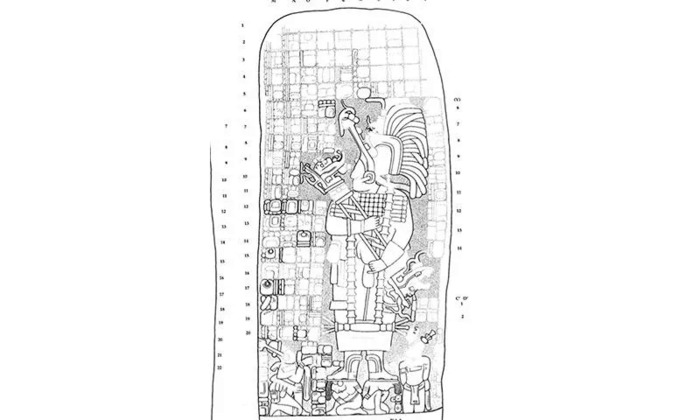An attempt to turn two tables on the hunter-queens and pull off a hat-trick. Fri 08 December 2023
Innocent near-virgin or homicidal huntress? Source: Lady Margaret Beaufort - Wikipedia 1
The dominant feature of Lady Margaret Beaufort's fabricated biography wasn't her property portfolio or her miraculous motherhood. It was the central role she was given in England's most boring civil wars.
The Wars of the Roses were allegedly fought between 1455 and 1487.
Their name and time frame should give us pause.
Why?
Because at the same time, halfway around the world, Central America's rulers were fighting their own civil wars:
Time to push up the daisies. Source: The Truth About Aztec Human Sacrifice
And time to smell the roses:
| Location | War(s) | Years Fought |
|---|---|---|
| Central America | Flower War(s) | 1454-1519 |
| Central England | Wars of the Roses | 1455-1487 |
| Table 1. A war by any other name would smell as rank. |
Both wars are highly fictionalised. Walter Scott brought England's War of the Roses to the public in 1829 2 and Daniel Brinton brought Aztec Flower Wars to the public in 1887 3. Their works seem to have been Romantic Movement efforts to explain away repeated bouts of death and up-cycling.
Today, Aztec Flower Wars don't hide their purpose. The goal was to maim victims then drag them to 'ritually cleansed' facilities where they were specially dressed, bled and their body parts upcycled.
From The Aztec 'Flower Wars' were far more deadly and insidious than the name suggests - History Skills:
They cut into the chest with razor-sharp obsidian blades and pulled out the heart, which they held skyward for the gods.
The body, now lifeless, fell down the steps. Onlookers cheered as the corpse was dragged aside or dismembered for later use.
Narrations of England's Wars of the Roses do hide their purpose. Hence the narrative of royal hunting parks like Rockingham Forest imply deer parks - but the parks contain enigmatic structures and other evidence that suggests humans were dismantled and their parts upcycled.
Of course, coincidence theorists would claim these resemblances are just coincidences. So let's see how far the coincidences stretch.
Starting with Saint Kyneburga AKA Lady Coneyborough and her unrolling of Roman Ermine Street near Castor - while out \<cough> collecting flowers.
Does this Roman road-building Saxon warrior-queen have an equivalent in Central America?
Lady K'awiil Ajaw on the tools. Source: Lady Kʼawiil Ajaw - Wikipedia
In this image, Lady K'awiil Ajaw's war-like soul is indicated by what is cowering beneath her soles. She's standing on a couple of bound opponents with two more kneeling next to them.
But it's what else lies beneath Ajaw's soles that should catch the coincidence theorist's attention.
From Did a Seventh-Century Warrior Queen Build the Maya's Longest Road - Smithsonian:
When Lady K’awiil Ajaw, warrior queen of the Maya city of Cobá, needed to show her strength against the growing power of Chichen Itza, she took decisive action, building the then-longest road in Mexico’s Yucatán Peninsula
Paved over uneven ground that had to be cleared of boulders and vegetation, it was covered in white plaster made with a recipe similar to Roman concrete.
Ermine Street, Mexico. Source: Did a Seventh-Century Warrior Queen Build the Maya's Longest Road
That Mexico's Ermine Street was paved with Roman-style concrete is all the more remarkable because the secret of Roman concrete was lost to womankind (and men) long before Europeans reached Mexico.
Beside the oddity of a Mayan warrior queen building a straight road with long-lost, Roman-style concrete, does Lady K'awiil Ajaw have anything else in common with miracle road-builder Saint Kyneburga AKA Lady Coneyburrow AKA Lady Ketilborough AKA Lady Hackelberg of Castor, Cambridgeshire?
| Born | Rule start | Rule End | Died | |
|---|---|---|---|---|
| Lady K'awiil Ajaw | AD 617 | AD 640 | AD 681 | AD 681 |
| Saint Kyneburga | AD 627-639 | AD 635 or AD 650 | AD 680 | AD 680 |
| Table 2. Another blooming coincidence. |
Links are to sources for each date.
It's curious how analysis of Lady K'awiil Ajaw suggests she is a representation of three or more Central American warrior queens 4. For she shares this multiplicity of royal names with Lady Hackelberg - vulgarly called Lady Ketilborough - and Lady Coneyburrow and Saint Kyneburga.
Besides - or actually above - the strange coincidences beneath the soles of her feet, Lady K'awiil Ajaw also shares another strange coincidence with Ermine Street's goddesses. We're told depictions of her often include the Mayan symbol for 'moon' positioned near her head.
In these respects Lady K'awiil Ajaw curiously resembles the recurring huntress wife of certain European kings:
You may know her as Diana the huntress. Source: Under the Crescent Moon (video now unavailable)
That would be the same Diana the Huntress that 18th century historians of the Fens claimed had been seen on Ermine Street between Stamford and Godmanchester. And who also masqueraded - or perhaps promenaded - on Ermine Street as a family-pack of wild hunting girls turned saints: Saint Tibba and Saint Eabba.
The synchronicities between Lady K'awiil Ajaw and Diana/Athena/Saint Kyneburga, etc, go beyond recurring timestamps, recurring Roman-like infrastructure and historians mooning the public.
Depictions of their headwear also reveal strange similarities between Central American warrior-rulers and Europe's hunter-saints and warrior-administrators. To show this, rather than repeat the image of Lady K'awiil Ajaw's headwear, here's a second Central American image:
It's the hat that fascinates. Source: Nasal Prosthesis
This panel is from Palenque, Mexico. It's the typical, elaborate head-dress associated with Central American warrior-kings.
Take a closer look:
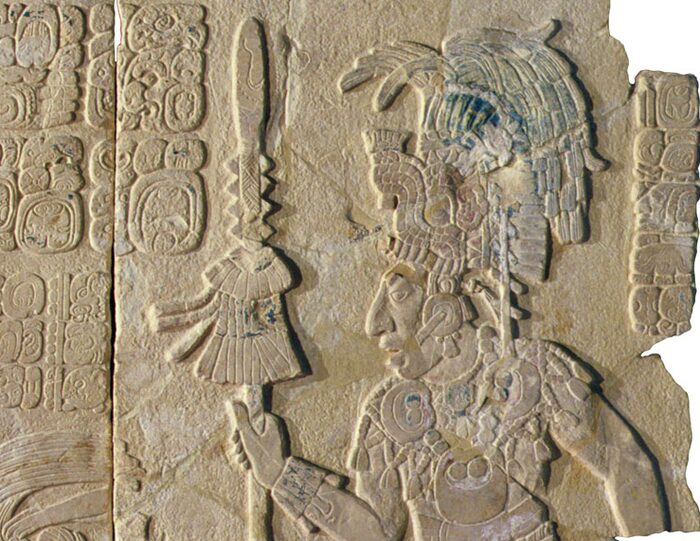
See the curious trumpet affair poking upwards from the front of his head-dress?
And the disk affair over his ear? Perhaps its a fastener for a chin strap or a mouth guard. Compare this head-dress with head-dresses sported on the other side of the Atlantic Ocean.
This is hungry Salomé as depicted in stained glass at Sainte-Jeanne d'Arc Church, Rouen, France:
Salomé prepares to process John the Baptist's head. 1869 panel. Source: Sainte-Jeanne d'Arc Church, Rouen
Quite what all the mass behind her head-dress is, we can't tell. But we do see a similar sized disk affair positioned over her ear. And a similar disk on the complex-looking head-dress of the woman in blue behind her.
Like Central American elites, Salomé's head-dress also sprouts a trumpet affair above her forehead. Here it is from the other side - as depicted in another stained glass from Sainte-Jeanne d'Arc Church:
Salomé's head in dance scene. 1869 panel. Source: Sainte-Jeanne d'Arc Church, Rouen
These protruding trumpet forehead-affairs have an analogue in uraeus - the serpent sometimes portrayed emerging from the foreheads of 'ancient' Egyptian elites.
Perhaps they depict a technical feature of Protective Personal Equipment of the past.
More likely, they came out of the same Romantic Movement studio that was tasked with explaining away features of certain births.
Features like this:
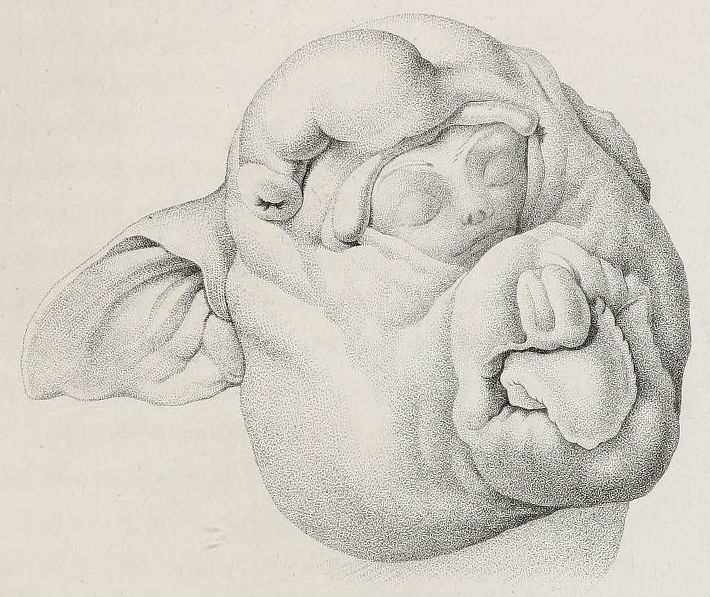
Beauty is in the eye of the beholder. Source: Pig-human hybrids - Pictures
Which they achieved with explanations like this:
From Athena - Wikipedia:
Athena was believed to have been born from the forehead of her father Zeus. In almost all versions of the story, Athena has no mother and is born from Zeus' forehead by parthenogenesis.
This 1841 German engraving of a human-pig hybrid depicts three features commonly seen in human-pig hybrids:
- Cyclopeanism
- Ears set further back (caudal ears)
- Frontal probosces
Anomalous foreheads are forensic tells. They are signs that sexual attraction has intersected with animals kept as food or as IHASFEMR.
And the likely truth of this assertion can be seen both in reality and in the myths composed to hide it.
From Athena - Wikipedia:
In a few others, such as Hesiod's Theogony, Zeus swallows his consort Metis, who was pregnant with Athena; in this version, Athena is first born within Zeus and then escapes from his body through his forehead.
'Zeus' even sounds like a Romantic Movement rewrite of Sus:

Sus scrofa is the elephant in the womb. Source: Pig-human hybrids - Pictures
So headwear worn by Salomé, Mayan and Egyptian elites may well include graphical references to devices used to hide the frontal probosces and caudal ears common in when humans were genetically new.
For more on recently hidden human anatomical anomalies, see Dating the Intelligent Pig - Part Two.
It's possible to guess why Castor's stone memorial to Saint Kyneburga can no longer be found 5. And why Ryhall's memorial to St Tibba has also disappeared.
Quite possibly they depicted figures too bizarre to romanticize 6.
Or perhaps they simply looked too much like this:
Lady K'awiil Ajaw on stella at Cobá, Mexico. Source: Did a Seventh-Century Warrior Queen Build the Maya's Longest Road
As university professors know, Greek mythology makes no sense. But then, nor does Egyptian or Mayan mythology. Unless you appreciate them as stories written to hide very real anatomical clues to humanity's origins.
Meanwhile, the physical evidence - the hunting parks, the recently disguised carcass dismantling facilities, the body parts in ossuaries, the secondary parts-processing industries, the too-similar flower wars and the warrior-queens - they are all the remains of something.
Something written by professional narrators:
100 myths you can believe in. Source: Westworld
More evidence of human hybridisation:
© All rights reserved. The original author/creator of each image, video, quote or text retains full ownership and rights. They are reproduced here on fair use ('fair dealing') terms.
-
This allegedly late-18th century stained glass depiction of Margaret Beaufort is in All Saints Church, Landbeach, Cambridgeshire. ↩
-
Traces of Aztec Cultural Memory in Sixteenth-Century Songs and Chronicles The Case of Tlacahuepan The Americas Cambridge Core ↩
-
See also Lady Kʼawiil Ajaw - Wikiwand ↩
-
And trust me on this, I left no stella unturned. ↩
-
Along with the many, many statues that have been decapitated and had their hands removed. ↩
More of this investigation:
Location Analysis: Peterborough-Stamford Wild Hunt,
More of this investigation:
Fingerprints of the Clean Up Team,
More of this investigation:
Location Analysis
More by tag:
#Tennyson Friend
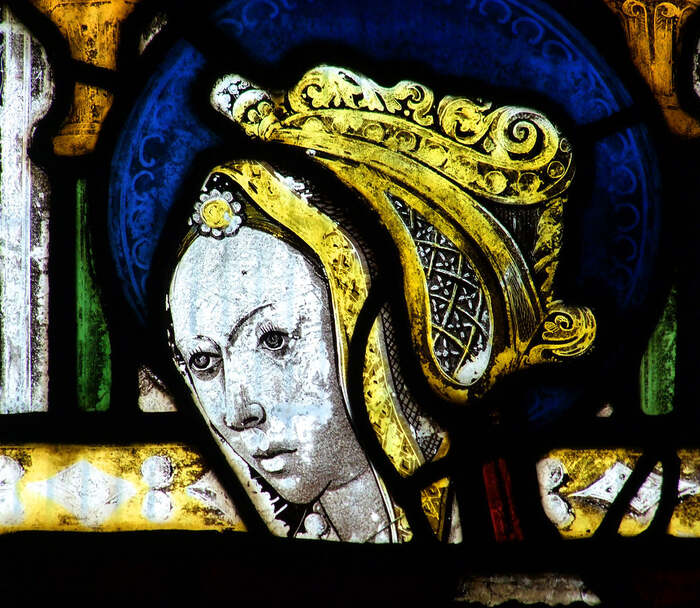
.jpg)
